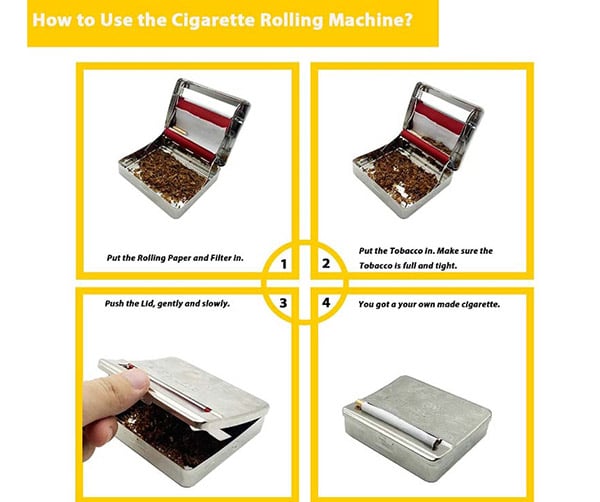Rolling by Hand or With a Joint Rolling Machine- are Joint Rollers Best?
Joint rolling machines are sometimes considered the tool for those new to the cannabis culture who have yet to develop the skills to roll a joint by hand.
However, these simple machines deserve a place in every cannabis enthusiast's kit. In this article, we will explain whether rolling by hand or with a joint rolling machine is best.

Rolling by Hand vs. with a Joint Rolling

While they may not show off your skills or creative flair for rolling cross joints, these nifty little tools certainly get the job done quickly and efficiently.
Efficiency/speed
Rolling multiple joints by hand can take a considerable amount of time.
It's also a lot of strain on your hands.
Try rolling 30 clouds of smoke for a party, and you'll probably get a hand cramp before making it through the lot.
Even if you're a seasoned toker, you'll probably take a minute or more to roll each joint well.
You can complete a joint in around 25 to 30 seconds with a joint rolling machine. If you're proficient and have the herb ground and crutches ready, you can get that down to around 10 seconds.
Clearly, using a joint rolling machine is the most effective method to roll a jay without industry-specific equipment. It also ensures you make perfect joints every time.
The other option is to skip the rolling altogether and use pre-formed cones and a cone packer. Some really cool and efficient electric herb grinders and cone fillers are the easiest way to make a joint.
Many smokers enjoy the ease and speed of using a good joint rolling machine and save the meditative hand-crafted joints for when they're ready to chill.
Easy to Use
The joint rolling machine is very simple to use. There are few moving parts, and most devices are very durable, requiring minimal fine motor skills (which can be a problem for some people).
For those who haven't mastered hand-rolling (or even tried it), a roller allows almost anyone to roll joints with minimal time and effort.
This is the first and easiest step to stop relying on others to meet your joint needs (whether it's a more expensive jay at the pharmacy or hassling a friend to roll joints for you) and allows you to control your marijuana consumption. Sometimes, letting the machine do the work after a long day is easier.
Uniformity
If you are not very proficient with hand rolls, your joint may end up canoeing or have poor airflow and not smoke well.
This is not only a pain to correct, but it's a waste of good weed and the last thing you want to deal with when trying to relax.
With a rolling machine, you'll always get the same good consistency. Hand rolling takes practice, and you'll have something to fall back on while perfecting the art.
Standard Dosing and Inconspicuous
Although more people are accepting of cannabis, there is still a stigma attached to it, and those larger cone-shaped joints tend to get more attention.
The clean, uniform, cigarette-like appearance produced by the rolling machine won't attract as much attention in a social environment.
The standard shape and size are more likely to be dismissed as a cigarette, at least until you spark it up, as the smell is still a possible giveaway.
Using a joint/cigarette roller will ensure that each joint is about the same size with the same content, so you can easily measure your dosage and see how many joints are worth of weed you have left in your stash.
Disadvantages of Rolling Machines

Despite their usefulness, there are some obvious downsides to using a rolling machine.
All this efficiency and uniformity comes at the cost of inflexibility and customization.
Let's take a look at some of the most common complaints about rollers:
Bad Joint Rolling Machines Make Bad Joints
Not all joint rolling machines are made equal.
While the devices are relatively simple, some cheaper ones are made from inferior-quality materials.
They may have sharp edges, or the action is smooth, meaning they tear or cut the rolling papers.
We highly suspect that most people who complain about joint rollers are simply using inferior-quality ones.
The critical part of the joint/cigarette roller is the rolling sheath.
These can vary in materials, from high-quality synthetic materials to old-fashioned vinyl.
While cheap and easy to find, vinyl ones tend to roll joints less evenly or make them too tight.
The joints you're left with can be easy to canoe and hard to draw. The result is a lousy smoking experience.
Some of the cheaper joint rollers close loosely and have a tendency to pop open if the joint is packed too tight.
They can pop open, spraying your herb all over and making a mess.
Look for rolling machines with a firm closing action but not too tight.
The roller should be able to sit close with the materials in it and move freely but without you needing to hold it closed.
All machines require a little trial and error to find the right amount of fill, but if your joint roller keeps messing up, then it's worth abandoning it for a better machine.
Joint rollers are relatively cheap, so if you buy a dud machine you don't like, you'll not be out of pocket by much.
User Error
Although rolling machines are easy to use, they still require some skill.
The most common mistake people make is not loading them evenly.
If the roller is filled unevenly with a lot of herbs on one end and only a little on the other, it will cause an uneven roll.
So be sure to place the papers and herbs evenly if you want the best results.
They look simple once you get the hang of them, but first-time users may need a few attempts to get the hang of them.
One Size Does Not Fit All
While rolling machines are consistent, they are also not flexible.
Except for minor variations, the machines require a certain amount of marijuana each time.
Many smokers like to adjust the size of their joints according to the demands of the intended occasion - large fatties in a social setting or a smaller pinner for a quick lift me up.
Cigarette rolling machines are usually available in two standard sizes, a standard 1¼ "cigarette paper size, and a 5" or "blunt" size. There are other non-standard sizes, such as king size, so be sure to check the roller you purchase so you can get the right paper for it.
Hand rolling is an art form that can adapt to fit a lot of herbs into a standard paper or make do with almost nothing.
The more you develop your rolling skills, the less you will need to use a rolling machine, as it won't always meet your requirements.
If you don't want the size or shape made by the machine, you're out of luck.
Disadvantages of Rolling by Hand
Skill and Practice
Hand-rolling requires significant practice to master the technique.
Achieving consistent results in terms of tightness, density, and even burn can be challenging for beginners.
Time and Effort
The hand-rolling process can be time-consuming, especially when preparing larger quantities of cigarettes.
This added effort may not be ideal for those looking for a quick solution.
Inconsistent Results
Inexperienced hand-rollers often struggle to achieve uniformity.
This can lead to variations in the quality of each cigarette, affecting the overall smoking experience.
Joints may burn unevenly or require more frequent relighting, which can be frustrating.
Physical Strain
For some, the repetitive motion of hand-rolling can lead to discomfort or strain in the hands and wrists, particularly during extended rolling sessions.
Material Waste
Without the proper technique, there’s a higher chance of wasting rolling papers or herbs, especially if joints are torn or packed incorrectly. This can add to the overall cost and diminish the experience
Conclusion
Some cannabis snobs may look down on this craft, but if you're with smoking buddies, this shouldn't be an issue, and if anyone does make fun of the joint roller, you're free not to share your herbs with them.
Remember that any disdain of the average marijuana user for using a roller is uncalled for.
Rolling machines are another tool in the cannabis toolbox that helps us enjoy marijuana, and their usefulness cannot be denied.
There's nothing like it if you need to get a joint rolled quickly.
Read more: What is the difference between smoking a bong and a joint?
FAQs
Do Rolling Machines Work?
Yes. Joint rolling machines do work and make uniform, consistent joints with minimal effort. Just take care to use them properly and get a good quality, dependable machine.
How to Use a Joint Roller?
Open the roller and put in the paper and crutch/filter.
Add the herb to the paper.
Then close the roller lid, and the joint will be ejected through the hole in the lid. Wet the gum strip and stick the paper down.
